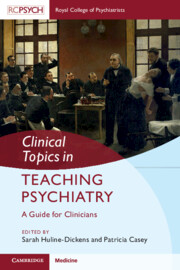Book contents
- Clinical Topics in Teaching Psychiatry
- Clinical Topics in Teaching Psychiatry
- Copyright page
- Dedication
- Contents
- Contributors
- A Note on the Cover
- Introduction
- Section 1 Teaching and Preparation
- Section 2 Teaching Methods
- Chapter 6 Small- and Large-Group Teaching
- Chapter 7 Whys and Hows of Patient-Based Teaching
- Chapter 8 Simulation-Based Learning in Psychiatric Training
- Chapter 9 Running Journal Clubs in Psychiatry
- Chapter 10 Workshops: An Important Element in Medical Education
- Chapter 11 Delivering a Good Lecture
- Section 3 Feedback, Assessment and Supervision
- Section 4 Bridging the Gaps: Foundation Years and Interprofessional Education
- Section 5 Technologies Old and New
- Section 6 Supporting the Trainee in Difficulty
- Index
- References
Chapter 11 - Delivering a Good Lecture
from Section 2 - Teaching Methods
Published online by Cambridge University Press: 24 November 2022
- Clinical Topics in Teaching Psychiatry
- Clinical Topics in Teaching Psychiatry
- Copyright page
- Dedication
- Contents
- Contributors
- A Note on the Cover
- Introduction
- Section 1 Teaching and Preparation
- Section 2 Teaching Methods
- Chapter 6 Small- and Large-Group Teaching
- Chapter 7 Whys and Hows of Patient-Based Teaching
- Chapter 8 Simulation-Based Learning in Psychiatric Training
- Chapter 9 Running Journal Clubs in Psychiatry
- Chapter 10 Workshops: An Important Element in Medical Education
- Chapter 11 Delivering a Good Lecture
- Section 3 Feedback, Assessment and Supervision
- Section 4 Bridging the Gaps: Foundation Years and Interprofessional Education
- Section 5 Technologies Old and New
- Section 6 Supporting the Trainee in Difficulty
- Index
- References
Summary
The traditional lecture has proven to be a remarkable survivor in the fickle world of medical teaching and learning. The traditional, 50-minute, didactic lecture is continually under attack, with critics arguing that its format is inflexible, audiences lose interest and there is insufficient interaction, if any, in most lectures. But while the lecture certainly violates many of the sacred tenets of contemporary education, it has nonetheless survived and even thrived in a world of incessant educational innovation and countless online teaching initiatives. Why?
Why is the traditional lecture still so popular? How has it survived? And how can we use the enduring appeal of the lecture format to best advantage in modern medical education and postgraduate training?
- Type
- Chapter
- Information
- Clinical Topics in Teaching PsychiatryA Guide for Clinicians, pp. 126 - 134Publisher: Cambridge University PressPrint publication year: 2022

